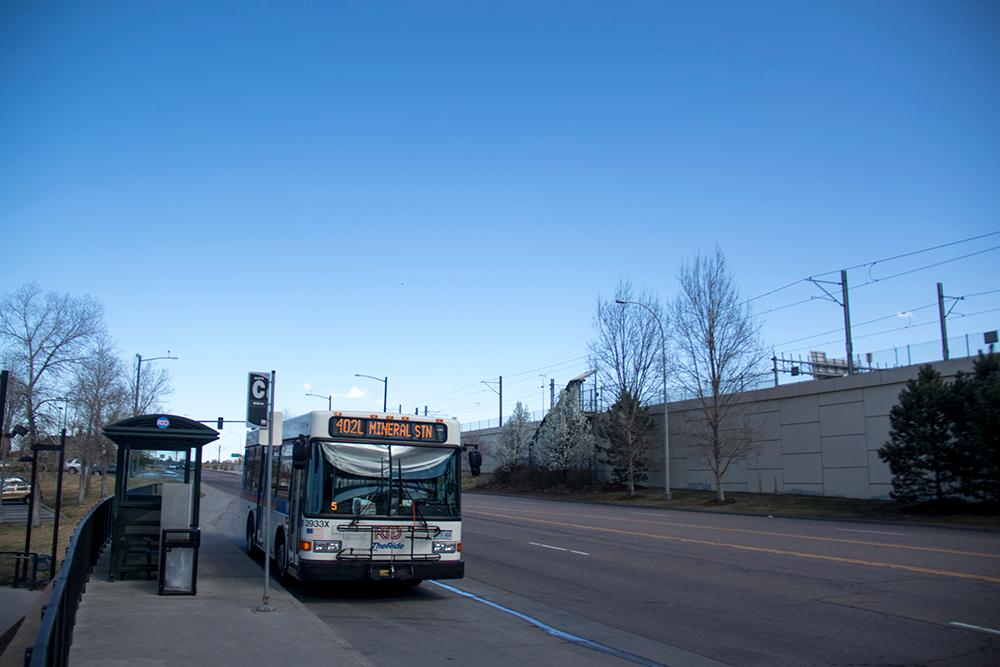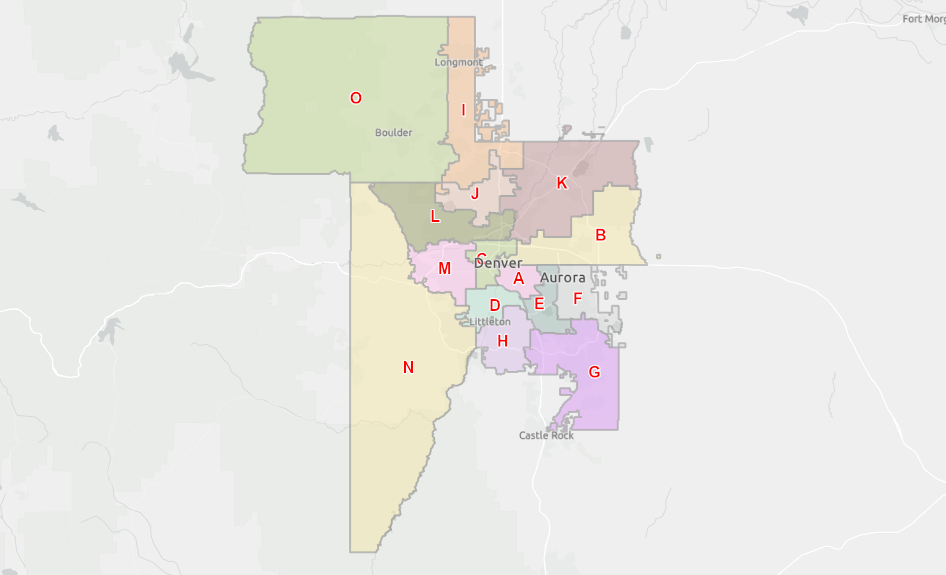
The Regional Transportation District’s ridership has fallen significantly in the last few years, off 5 percent from 2015. And the agency has put off massive capital projects like its long-sought Boulder train because of budget constraints.
Those are two big reasons RTD’s board of directors is about to have a long, difficult conversation about what the agency’s future should look like.
The debate kicked off in earnest in late July and centered around a tricky question: Should RTD try to cover the entirety of its 2,342-square mile district, with sometimes infrequent but far-reaching service? Or should it cut some low-ridership lines and instead focus on high-density corridors where transit is more popular?
CPR News spoke with every member of RTD’s 15-person elected board about what they thought about those questions. Most noted that the agency’s two-year revamp process, dubbed “Reimagine RTD,” just started and many said they needed more information and feedback from the public.
But most board members said RTD has a duty to provide a basic level of service to everyone in the district. People across the district pay the same 1 percent sales tax that funds RTD, they noted.
A few said they’d strongly support focusing on higher ridership.
“If we want to talk about sustainability for the agency, we're going to have to shift some from that coverage to the high focused ridership,” said board member Natalie Menten.
The question of whether to focus on ridership versus coverage goes beyond transit: One fix could be to encourage more dense, transit-oriented development that could lead to higher ridership. That idea divided board members.
“I lived in Manhattan for 10 years. I had enough. I specifically did not want urban density,” said board member Judy Lubow.

Board Chair Doug Tisdale said the board will discuss the matter further at their meeting on Tuesday, Aug. 27 and in public outreach after that. Here are the highlights of what each board member told CPR News:
Kate Williams, District A.
Denver, including downtown, Capitol Hill, Cherry Creek.
Williams, who represents one of RTD’s densest districts, gave the most full-throated support for focusing on high ridership.
“RTD is about moving people, not about moving buses,” she said. “I see no point in having a bus and a driver and fuel and, and air quality, etc., moving on a route that has three riders on it. So I'm always about moving people, not about moving equipment.”
Judy Lubow, District I.
Broomfield, Lafayette, Longmont.
Lubow said she’d have a hard time supporting a plan that could increase ridership across the entire district but would result in service cuts to her own.
“That doesn't mean I wouldn't do it, but I would look at it very, very carefully,” she said.
Lubow also said she doesn’t feel an obligation to encourage cities in her district to build more densely.
“I wouldn't want to do it,” she said. “I mean, those of us who live here, many of us live here by choice. I lived in Manhattan for 10 years. I had enough. I specifically did not want urban density, but I'm in a district where I pay taxes and each of us individually pays our fair share of the taxes. And we have a right to be treated with equity.”
Natalie Menten, District M.
Lakewood, Golden.
Menten said she’s inclined to push it toward ridership to help shore up RTD’s finances.
“We've got routes where the subsidy is completely unacceptable and it'll continue to further pull the agency down on those costs, without much reward,” she said.
Low-ridership areas could be serviced with alternatives to fixed-route buses, like vouchers for other transportation services, Menten said. She said she doesn’t want to encourage more density in the already quickly growing Front Range. And she’s prepared to tell her constituents to expect service cuts.
“I, for one, have really not had a big problem going to the constituents and saying, ‘Um, you knew it from the get go. I ran on the platform of being a financial watchdog, and this is what it takes.’”
Angie Rivera-Malpiede, District C.
Denver, including Globeville, Highlands, Athmar Park, Westwood.
Rivera-Malpiede said she felt really stuck on which direction RTD should go.
“I want to be able to have frequency and buses available so that if I'm working a shift, I know that I have reliable transportation to get to and from work,” she said. “Because I feel like we should have service for the entire district.”
Like District B's Shontel Lewis, Rivera-Malpiede is also concerned about transit-dependent residents who’ve been pushed into the district’s farther reaches.
“They work here, but they have to live further out,” she said. “And what happens to them? And how do we level that playing field to make sure that transportation is affordable?”
Vince Buzek, District J.
Westminster, Federal Heights, Northglenn.
Buzek said if RTD were to focus on ridership, he’d need more information about what exactly that meant for his district.
“My fear is that, you know, the people that I represent on the north end will once more, either be waiting or not getting things that they really want,” Buzek said, referencing the wait communities like Northglenn have had for their promised FasTracks train. Part of the N Line is set to open early next year.
Buzek said RTD’s sheer size — 2,342 square miles — makes it difficult to provide a high level of service everywhere.
"RTD's big. You know, maybe it's too big,” he said. “There are going to be, by definition, areas that don't get a bus on every corner. And it just can't happen that way."
Shontel Lewis, District B.
Denver, including downtown, Park Hill, Green Valley Ranch.
Lewis said she hasn’t yet come down on one side of the ridership versus coverage question.
“I think it's important for us to ask the right questions and grapple with the data before coming to a conclusion that impacts the lives of everyday people,” she said.
She’s worried that focusing on density exclusively could leave out people who’ve been priced out of historic neighborhoods like Five Points.
“It's really looking at her system from a lens of equity,” Lewis said. “How do we ensure that we are getting people to the places that they need to go, whether that's in frequency or in coverage?”
Ken Mihalik, District G.
Lone Tree, Centennial, Parker.
Mihalik said he’s leaning toward focusing on ridership. That may mean cutting less popular routes in his district, but could also lead to more frequency on highly popular commuter routes into downtown Denver.
“Looking at it from the sense of greatest efficiency, people don't want to be stuck on any road longer than they have to,” he said. “But if that shift, particularly in bus strategy, significantly increases utilization, and fewer cars are on I-25, then it makes sense as a utilitarian argument. It makes sense for more people.”
Lynn Guissinger, District O.
Boulder, Longmont.
Guissinger said RTD is obligated to provide basic service to everyone who pays for it. And she thinks the ridership versus coverage debate doesn’t cover the entirety of what RTD needs to tackle.
“I think it's a piece of the puzzle of what we need to figure out. I don't think it's certainly the whole question,” she said.
Jeff Walker, District D.
South Denver, Englewood.
Walker noted when RTD reduced service in the suburban southwest part district a few years ago, there wasn’t an outcry.
“Some folks were happy with fine with reduced service … because it wasn't necessarily needed in those areas,” he said. Still he said, he’s not yet sure where he lands on the question.
Walker said he’ll be looking for input from the cities RTD serves, and he hopes they’ll encourage more transit-friendly development.
“What I've heard from a lot of planners and traffic engineers around the region is, ‘Our streets are choking. And there is not much more right of way that can be obtained.’” he said. “So I'll be looking for a real regional effort from jurisdictions, their planners, their engineers, their staff, and the residents of areas. And RTD of course.”
Claudia Folska, District E.
East Aurora, southeast Denver.
She said given RTD’s limited resources, it needs to look at how it can serve the most people it can in the most fiscally responsible way possible. She also said cities and their residents need to decide if they want public transportation.
“I'd love to live up in the mountains in a remote area,” Folska said. “That's a really appealing idea to me, but I know that it's just not accessible. And so if I want to have great accessibility through public transportation, I need to live where it is.”
Bob Broom, District F.
West Aurora.
He said he’d prefer a “delicate balance” between ridership and coverage. He said while his constituents would likely want him to protect service in his district, he also feels an obligation to what’s best for the district as a whole.
“If the district tried to just focus on urban core, I'd say that's a question I'd have to agonize over in the budgeting process,” Broom said.
Troy Whitmore, District K.
Commerce City, Thornton, Brighton.
Whitmore said any ridership-focused plan that cut service in his mostly suburban and rural district would be “problematic in concept at least.”
“My constituents and the leaders in my communities deserve at least a minimal service standard,” he said. “And I am concerned that we will not have that and my constituents pay the same amount of sales and use taxes as anybody else in the metroplex.”
Shelley Cook, District L.
Arvada, Adams County.
Cook said she thinks the question is too simplistic a view of RTD’s future.
“I just don't see it as black and white,” she said.
On the question on encouraging density, Cook said Olde Town Arvada makes for an interesting case study. It’s the most popular stop on the new G Line, and Cook said its mixed-use development and density has helped encourage all-day travel in and out of it. She hopes other cities take note and start developing their own spots like it.
“Maybe [RTD] can even, without the associated ridership to support it, commit to a level of service in those areas until it catches up,” she said.
Doug Tisdale, District H.
Cherry Hills Village, Littleton, Highlands Ranch.
Tisdale said he needs more information and wants to talk to stakeholders before making any decisions.
“I need to look at what are the needs in our district,” he said. “We have relatively good coverage, but I do hear from people about transit oases that we have. We've got nothing on Bellevue. We've got nothing on Orchard.” But, he said, there’s great access in other areas.
Peggy Catlin, District N.
Morrison, Evergreen, Conifer, Columbine.
Catlin is also skeptical of the ridership versus coverage dichotomy, but said she’s coming to the discussion with an open mind.
“ I clearly represent an area that doesn't have any rail service and has very limited bus service,” she said. “But those who use it really depend on it. And so I’Il have to keep in mind their interests. But I want to balance it with the region wide needs and priorities.”








